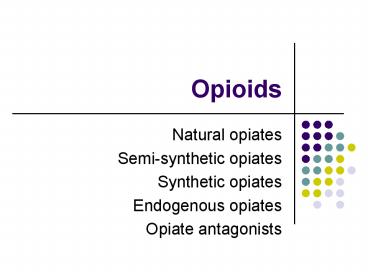Opioids PowerPoint PPT Presentation
1 / 19
Title: Opioids
1
Opioids
- Natural opiates
- Semi-synthetic opiates
- Synthetic opiates
- Endogenous opiates
- Opiate antagonists
2
History of opioids
- Opium, the sap of the seed pod of Papaver
somniferum, referred to as early as 3000 B.C. and
found in Spanish burial sites dated 4200 B.C. - Greeks and Romans used opium to produce
constipation, sleep, and ultimately as a panacea
Hippocrates, Pliny, and Galen - May be the gall of Scripture (Matt. 2734)
3
More history...
- Opium use spread from its origins in Turkey with
the expansion of Islam. - Arab traders took it to India and China.
- In Persia, Avicenna (ibn-Sina, 980-1037)
recommended opium for eye disease and diarrhea. - In 1644, the Chinese emperor banned tobacco
smoking Chinese switched to smoking opium.
4
And some more history...
- Arabs trading with Vienna brought opium back to
Europe - Paracelsus (1493-1541) and Thomas Sydenham,
(1624-1689), father of clinical medicine - "Among the remedies which it has pleased Almighty
God to give to man to relieve his sufferings,
none is so universal and so efficacious as
opium."
5
Opium and politics
- British control of opium production in India
- Usage in Britain climbed during the 1800s
- Peaked at 10 pounds per 1000 people, 1870
- Laudanum
- The Opium Wars (1841, 1856-58, 1860)
6
Legal controls on opium
- The Chinese effort Opium dens
- Britains Pharmacy Act, 1868
- The disease model and the British system
- The American experience 13 pounds per 1000
people patent medicines, soldiers disease (or
army disease) in Civil War - Laudanum and paregoric
- Harrison Narcotics Act, 1914
- Heroin banned in 1924
7
Analgesia
- Nociceptors Activated by physical or chemical
injury or threat of injury - When stimulated, nociceptive neurons ultimately
trigger the release of substance P. - Opioids, both endogenous and as drugs, inhibit
the release of substance P analgesia. - Pain information is relayed to the RAS, the
thalamus, the somatosensory cortex (for early
pain), and the anterior cingulate cortex and the
limbic system (for late pain).
8
Brain blocking of pain
- Thalamus, brainstem, and limbic system have many
opioid receptors - Descending neurons travel from sites in the
brainstem, such as the PAG, in the raphe (which
releases 5-HT)and near the locus ceruleus (which
releases NE), in turn activating descending
neurons. - Descending neuron activity inhibits the release
of glutamate and substance P in the spinal cord. - Spinal interneurons release endorphins to inhibit
spinal projection neurons.
9
Opiate analgesia
- In the spinal cord
- On spinal interneurons, morphine mimics
endorphins - On descending neurons
Directly inhibiting the spinal projection neuron
Directly inhibiting the spinal interneuron
Directly exciting the inhibitory opioid
interneuron
10
Opiate analgesia in the brain
- Morphine acts on opioid receptors in PAG and
raphe - Activation inhibits cells in the spinal cord
- Locus ceruleus cells normally excite (with NE)
spinal pain transmission - PAG and opioid action on locus ceruleus
hyperpolarize and thus inhibit m-receptors
11
Opiates Natural and semi-synthetic
- Morphine (10 of opium) and codeine, .5
- Isolated by Frederick Serturner, 1803
- Injected with invention of hypodermic needle,
1853 - Heroin Morphine with two acetyl groups
- Diacetylmorphine made by Bayer in 1898, sold as
non-addictive - Dreser, inventor of aspirin, used the same trick
of adding an acetyl group to get heroin
12
Synthetic opiates
- Meperidine (Demerol) Shorter-acting
- Methadone (Dolophine) Orally effective
- Pentazocine (Talwin, 1967)
- Propoxyphene (Darvon)
- Buprenorphine (Buprenex) Partial agonist
- Oxycodone (OxyContin, Percodan, Percocet)
- Hydrocodone (Vicodin, Lorcet, 200 generics
13
Opiate antagonists
- Pure antagonists Naloxone and naltrexone
- Mixed agonist-antagonists Nalorphine
- Endogenous opiates
- Enkephalins and endorphins
14
Opioid receptors
- Three genetically-controlled sets of receptors m
(mu), k (kappa), and d (delta) - Mu receptors are in all pain-control areas of the
brain and spinal cord, in the respiratory control
centers, and nucleus accumbens. Mu receptors
respond to morphine and fentanyl (China White).
15
Opioid receptors...
- Kappa receptors are in pain areas and nucleus
accumbens, but also in deeper layers of cerebral
cortex. Kappa receptors respond to mixed
agonist-antagonists, like pentazocine (Talwin) - Delta receptors are found in pain areas, nucleus
accumbens, and limbic system. They respond to
endogenous opiates.
16
Opioid addiction
- Most opioids increase DA activity from VTA to
nucleus accumbens - However, k-agonists like dynorphin decrease DA
activity associated with aversive effects of
opioids
17
Dealing with opioid addiction
- Mixed tolerance and receptor-specific
cross-tolerance develop rapidly - Sensitization may occur for the craving effect
- Dependence and cross-dependence are dramatic
- May require lifelong opioid therapy
- Lifestyle factors are associated with opioid
addiction lack of productivity - Naltrexone maintenance therapy
- Methadone or LAAM maintenance therapy
- Buprenorphine (a partial mu agonist) maintenance
less euphoria permits larger prescriptions
18
Why do people abuse opioids?
- Predisposition
- Psychopathological basis for euphoria
- Deficient endorphin systems
- Painful emotional states
- Maintenance
- Avoid withdrawal (Negative reinforcement)
- Experience euphoria (Positive reinforcement)
- Alleviate painful emotional states
- Damaged endorphin system need opioids
- Cuing by environment and/or mood state
19
(No Transcript)

